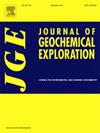南岭志留系平潭钨矿成因及岩浆-热液演化:来自白钨矿和磷灰石地球化学及年代学的制约
IF 3.3
2区 地球科学
Q1 GEOCHEMISTRY & GEOPHYSICS
引用次数: 0
摘要
华南地区已报道了一系列志留系W型成矿事件,但成矿过程仍未得到很好的约束,这阻碍了对矿床成因的全面认识,并阻碍了进一步勘探计划的部署。本文以新发现的志留系平潭钨矿为例进行了研究。对白钨矿和磷灰石进行了显微结构和地球化学综合研究,对磷灰石进行了U-Pb年代学研究,确定了钨的成矿时间、成矿流体的起源和演化。根据BSE和CL图像,确定了白钨矿(Sch)和磷灰石(Ap)两种类型:蚀变花岗岩白钨矿阶段的Sch A (A1和A2)和Ap I,以及石英白钨矿阶段的Sch B (B1和B2)和Ap II。多期白钨矿Mo含量和Eu/Eu*比值表明,各成矿期流体fO2由早到晚呈递减趋势。多期磷灰石Eu/Eu*比值表明,从蚀变花岗白钨矿期到石英白钨矿期,流体fO2增加。磷灰石和白钨矿生长各阶段的Y/Ho比值表明,初始流体来源于寄主斑岩型黑云母二长花岗岩,磷灰石早期结晶导致白钨矿中Y和Ho的耗蚀。支持向量机双标图显示,Apⅰ为岩浆成因,Apⅱ为热液成因。热液Apⅱ的U-Pb年龄为433.7±9.7 Ma (2σ, MSWD = 1.9),与斑岩型黑云母二长花岗岩的侵位年龄(431 ~ 430 Ma)一致。这些资料表明,平潭钨矿床是一个典型的蚀变花岗岩型钨矿床,其成因与寄主志留系斑岩型黑云母二长花岗岩有关。此外,根据磷灰石中F和Cl的含量估算熔体和流体中F和Cl的含量,表明富挥发性蚀变斑岩黑云母二长花岗岩具有较大的W成矿潜力。结合前人对志留系钨成矿作用的研究,我们认为志留系可能是华南钨成矿的另一个重要时期,同时期高演化、富挥发物质的花岗岩可能是钨矿床新的找矿目标。本文章由计算机程序翻译,如有差异,请以英文原文为准。
Genesis and magmatic-hydrothermal evolution of the Silurian Pingtan W deposit, Nanling Range, South China: Constraints from scheelite and apatite geochemistry and geochronology
A cluster of Silurian W mineralization events have been reported in South China but the ore-forming processes remain not well-constrained, impeding a comprehensive understanding of deposit genesis and hindering the deployment of further exploration programs. In this study, we examine the newly discovered Silurian Pingtan W deposit as a case study. We undertook a comprehensive study of microtextures and geochemistry on scheelite and apatite, and U–Pb geochronology on apatite to determine the timing of W mineralization as well as the origin and evolution of the ore-forming fluids. Based on BSE and CL images, we identify two types of scheelite (Sch) and apatite (Ap): Sch A (A1 and A2) and Ap I in the altered granite-scheelite stage, and Sch B (B1 and B2) and Ap II in the quartz-scheelite stage. The Mo contents and Eu/Eu* ratios of multi-stage scheelite suggest a decrease in fluid fO2 from the early to late stages within each mineralization phase. The Eu/Eu* ratios of multi-stage apatite indicate an increase in fluid fO2 from the altered granite-scheelite stage to the quartz-scheelite stage. The Y/Ho ratios of these phases of apatite and scheelite growth imply that the initial fluids originated from the host porphyritic biotite monzogranite, and early-stage apatite crystallization led to the depletion of Y and Ho in scheelite. A support vector machine biplot shows that Ap I is magmatic in origin, while Ap II is hydrothermal in origin. The hydrothermal Ap II yields a U–Pb age of 433.7 ± 9.7 Ma (2σ, MSWD = 1.9), aligning with the emplacement ages (431–430 Ma) of the porphyritic biotite monzogranite. These data imply that the Pingtan W deposit represents a typical altered-granite type W deposit genetically linked to its host Silurian porphyritic biotite monzogranite. In addition, the estimated F and Cl contents in melt and fluid based on their contents in apatite indicate that the volatile-rich altered porphyritic biotite monzogranite has great W mineralization potential. Considering previous studies on the Silurian W mineralization, we propose that the Silurian may represent another significant period for W mineralization in South China, with contemporaneous highly evolved and volatile-rich granites serving as a new exploration target for W deposits.
求助全文
通过发布文献求助,成功后即可免费获取论文全文。
去求助
来源期刊

Journal of Geochemical Exploration
地学-地球化学与地球物理
CiteScore
7.40
自引率
7.70%
发文量
148
审稿时长
8.1 months
期刊介绍:
Journal of Geochemical Exploration is mostly dedicated to publication of original studies in exploration and environmental geochemistry and related topics.
Contributions considered of prevalent interest for the journal include researches based on the application of innovative methods to:
define the genesis and the evolution of mineral deposits including transfer of elements in large-scale mineralized areas.
analyze complex systems at the boundaries between bio-geochemistry, metal transport and mineral accumulation.
evaluate effects of historical mining activities on the surface environment.
trace pollutant sources and define their fate and transport models in the near-surface and surface environments involving solid, fluid and aerial matrices.
assess and quantify natural and technogenic radioactivity in the environment.
determine geochemical anomalies and set baseline reference values using compositional data analysis, multivariate statistics and geo-spatial analysis.
assess the impacts of anthropogenic contamination on ecosystems and human health at local and regional scale to prioritize and classify risks through deterministic and stochastic approaches.
Papers dedicated to the presentation of newly developed methods in analytical geochemistry to be applied in the field or in laboratory are also within the topics of interest for the journal.
 求助内容:
求助内容: 应助结果提醒方式:
应助结果提醒方式:


